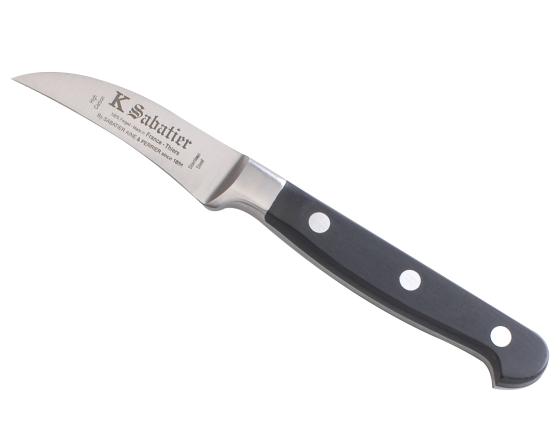A curved paring knife is a type of kitchen knife with a short, sharp blade that is ideal for peeling and slicing fruits and vegetables. The curved blade allows the user to apply more pressure when cutting through tough skins, making it a versatile tool for both delicate and tough jobs. Curved paring knives are available in both stainless steel and carbon steel varieties, each with its own set of benefits and drawbacks.
Stainless steel knives are more resistant to rust and staining, but carbon steel knives are sharper and easier to sharpen.
A curved paring knife is a great tool to have in your kitchen. It can be used for a variety of tasks, such as peeling and slicing fruit and vegetables.
A curved paring knife has a blade that is slightly curved, which makes it ideal for peeling fruit and vegetables.
The curve of the blade provides more control when peeling, so you can avoid taking off too much skin.
A curved paring knife can also be used for slicing fruits and vegetables. The curve of the blade helps to create even slices.
If you are looking for a versatile knife to add to your kitchen arsenal, then consider a curved paring knife. It can be used for a variety of tasks, and it will make your life in the kitchen easier.
Curved Paring Knife Use
A curved paring knife is a small, sharp knife that is used for various food preparation tasks. The blade of a curved paring knife is curved and has a pointed tip. This type of knife is typically used to peel or trim fruits and vegetables.
It can also be used to remove the seeds from a tomato or to cut small pieces of meat. Curved paring knives are available in different sizes, but the most common size has a blade that is three inches long.
Tourne Knife
A Tourne knife is a French cooking knife that is used for slicing and julienning vegetables. It is also known as a vegetable knife or a French chef’s knife. The blade of the Tourne knife is curved, making it easy to slice vegetables into thin strips.
The word “tourne” means “to turn” in French, which refers to the way the blade curves around the vegetable.
The Tourne knife was invented by Georges Auguste Escoffier, who is considered to be one of the most influential chefs in history. He created this knife in order to make it easier to julienne vegetables.
prior to this invention, cooks would use a straight-bladed knife to slice vegetables into thin strips, which was time-consuming and often resulted in uneven slices.
The Tourne knife has become an essential tool for any cook who wants to create perfectly sliced and julienned vegetables. If you’re looking for a quality Tourne knife, we recommend checking out the Victorinox Fibrox Pro 8-Inch Chef’s Knife.
This knives features a lightweight design that makes it easy to handle, and its sharp blade ensures precise cuts every time.
Bird’S Beak Paring Knife
A bird’s beak paring knife is a specialized kitchen knife that is designed specifically for trimming and shaping the delicate skin and flesh of birds. These knives typically have a very thin, sharp blade that is able to maneuver around small bones and joints without damaging the meat. They are also often equipped with a curved tip, which helps to prevent slipping and accidental punctures.
If you are planning on doing any serious cooking with poultry, then a bird’s beak paring knife is an absolute necessity. While you can certainly get by with using a regular kitchen knife for this task, it will likely take you much longer and the results will not be nearly as attractive. With one of these specialized knives, you can quickly and easily remove any unwanted bits of skin or fat, leaving behind only clean, beautiful meat.
Straight Vs Curved Paring Knife
There are a few different types of paring knives, but the two most popular are the straight and curved paring knife. Both have their own unique benefits that make them ideal for different tasks. So, which one is right for you?
The straight paring knife is the most basic type of paring knife. It has a simple blade with a sharp point that is great for peeling and slicing fruits and vegetables. The main benefit of this type of knife is its simplicity.
It’s easy to use and maintain, and it’s very versatile. You can use it for a variety of tasks in the kitchen, from peeling potatoes to slicing apples.
The curved paring knife has a slightly more complex blade than the straight paring knife.
The curve allows you to get into tight spaces and produce cleaner cuts. This type of knife is great for detailed work like carving or trimming vegetables. It can also be used for mincing garlic or ginger.
The curved blade can take some getting used to, but it’s worth it if you want precision in your cutting!
Small Curved Kitchen Knife
When it comes to kitchen knives, there are all sorts of different shapes and sizes. But when it comes to finding the perfect knife for your needs, sometimes the best option is a small curved knife.
A small curved knife is perfect for slicing and chopping fruits and vegetables.
It’s also great for mincing garlic or ginger. The curve of the blade helps to create a rocking motion that makes chopping easier and quicker. And because the blade is smaller, it’s also easier to control.
If you’re looking for a versatile kitchen knife that can handle all sorts of different tasks, then a small curved knife is a great option. It’s sharp, easy to use, and will make quick work of any cutting task in the kitchen.
Bird’S Beak Paring Knife Uses
A bird’s beak paring knife is a specialized kitchen knife that is designed for trimming and shaping the delicate skin and flesh of birds. This type of knife has a very sharp, thin blade that is able to easily pierce through the tough exterior of a bird’s body without damaging the tender flesh underneath.
There are many different ways that a bird’s beak paring knife can be used in the kitchen.
One common use is to trim away any excess skin or fat from around the bird’s neck area. This helps to create a neater appearance and can also help to prevent the skin from sticking to the meat during cooking.
Another common use for this type of knife is to shape the tip of the bird’s beak.
This can be done for aesthetic purposes or to help the bird eat more easily. In some cases, the tips of birds’ beaks can become overgrown and may need to be trimmed back with a paring knife on occasion.
Overall, a bird’s beak paring knife is an extremely versatile tool that can be used for a variety of tasks in the kitchen.
If you frequently cook with poultry, it is definitely worth investing in one of these knives!

Credit: www.sabatier-shop.com
What is a Curved Paring Knife Used For?
A curved paring knife is a kitchen knife that is used for various tasks such as peeling and slicing fruits and vegetables. It is also suitable for cutting meat and fish. The blade of this knife is usually shorter than four inches (10 cm) and has a curved edge.
This makes it easier to control when compared to a straight-edged knife.
What is the Name of a Paring Knife With a Curved Blade?
A paring knife with a curved blade is called a Bird’s Beak Paring Knife. This knife gets its name from its similarity in shape to a bird’s beak. The curved blade of this knife is great for peeling and shaping fruits and vegetables.
The Bird’s Beak Paring Knife is a versatile tool that can be used for a variety of tasks in the kitchen. In addition to peeling and shaping fruits and vegetables, this knife can also be used for mincing herbs, slicing garlic, or removing seeds from peppers.
If you’re looking for a paring knife with a curved blade, the Bird’s Beak Paring Knife is a great option.
This versatile knife will make quick work of any task in the kitchen.
What is a Birds Beak Paring Knife Used For?
Assuming you are asking about a kitchen knife: A birds beak paring knife is a small, pointed knife that is used for various tasks in the kitchen, such as peeling and slicing fruit and vegetables. It gets its name from its shape, which resembles a bird’s beak.
What are the Different Types of Paring Knives?
Assuming you would like an in depth answer:
Paring knives come in many shapes and sizes, but there are three main types of paring knives: the bird’s beak paring knife, the sheepsfoot paring knife, and the spear-point paring knife. Each type of knife has a different blade shape that is designed for specific tasks.
The bird’s beak paring knife is named for its sharp, curved blade that resembles a bird’s beak. This type of knife is perfect for peeling and slicing fruits and vegetables with thin skin. The curved blade allows you to make clean, precise cuts without damaging the delicate flesh beneath the skin.
The sheepsfoot paring knife has a straight blade with a blunt tip. This type of knife is good for general purpose slicing and cutting. The blunt tip makes it safe to use on softer fruits and vegetables, as well as meat.
Because the sheepsfoot blade doesn’t have a point, it can also be used for safety applications such as food prep in daycare centers or schools.
The spear-point paring knife has a sharp, pointed blade that tapers to a fine point. This type ofknife is ideal for detailed work such as removing seeds from peppers or carving vegetables into decorative shapes.
The sharp point also makes this type ofknife useful for piercing holes into soft fruits so that they can be threaded onto skewers or stringed together.
Tupperware – How To Use the Curved Paring Knife?
Conclusion
A curved paring knife is a great tool to have in your kitchen. It can be used for a variety of tasks, such as peeling and slicing fruit and vegetables. The curved blade allows you to get into tight spaces and make precise cuts.
This type of knife is also great for removing seeds from fruits and vegetables.
